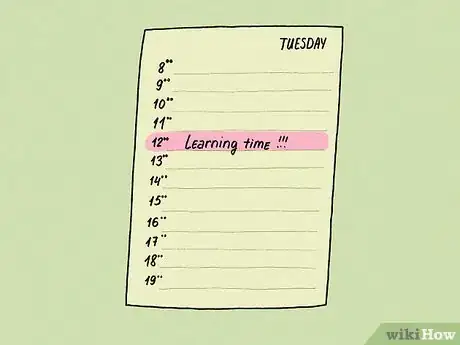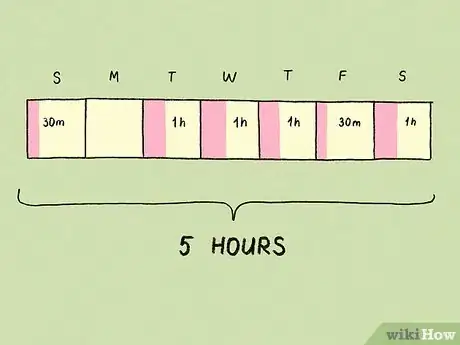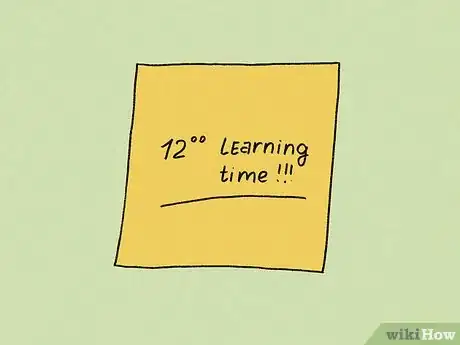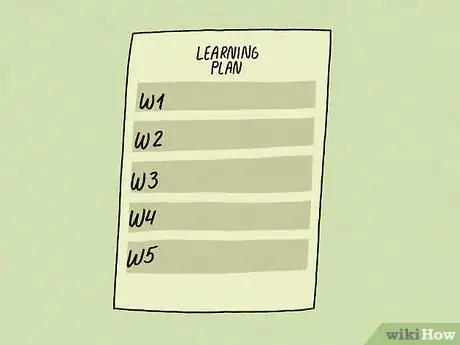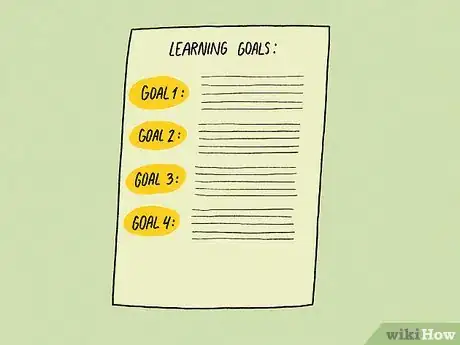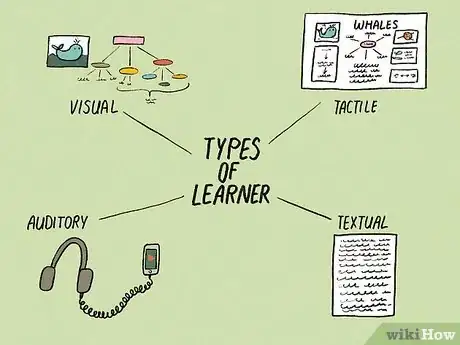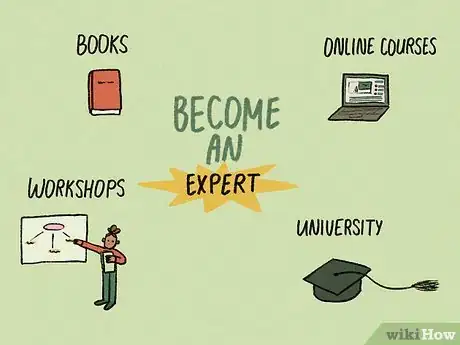This article was co-authored by Emily Listmann, MA. Emily Listmann is a private tutor in San Carlos, California. She has worked as a Social Studies Teacher, Curriculum Coordinator, and an SAT Prep Teacher. She received her MA in Education from the Stanford Graduate School of Education in 2014.
There are 7 references cited in this article, which can be found at the bottom of the page.
wikiHow marks an article as reader-approved once it receives enough positive feedback. This article received 19 testimonials and 99% of readers who voted found it helpful, earning it our reader-approved status.
This article has been viewed 19,178 times.
Many people are extremely busy every day, so finding time to learn can be hard. However, being a life-long learner will help you at work, make you feel more knowledgeable about the world, and enrich your life. Fortunately, there are many ways to learn, ranging from reading books to watching documentaries. You can even visit local museums in your leisure time! You can set aside time to learn every day by making time to learn, organizing your learning time, deciding how you'll learn, and choosing what you'll learn.
Steps
Making Time to Learn
-
1Write learning time into your schedule. In order to set aside time every day to learn, write it into your schedule. Create a block in your day to day schedule that is specifically made for learning. Try to make it a time that will be the best for learning. This means avoiding times when you will not be able to focus, such as right before bed when you may be too tired or first thing in the morning when you are still waking up.
- This may be hard with a full work schedule and a family or everyday obligations, but scheduling time to learn will help prioritize it in your life every day.
- You can write out your schedule weekly or monthly, whatever works best for you.[1]
- About an hour a day is considered the most beneficial for long-term learning.[2]
-
2Replace empty time in your day. When you are looking for placed to add in learning time, think about empty times in your day. Instead of wasting time doing mindless activities, switch the time out for learning time. This could be times when you find yourself flipping through the channels aimlessly or scrolling through things on your phone.
- You may not even realize that these times exist until you start looking at your daily activities. If you find a chunk of time where you aren’t being productive or doing something meaningful to you, switch this time over to learning time.[3] [4]
- Remember that there are many ways to learn. For example, you could spend some of your family time every weekend learning together by visiting local museums, going to the zoo, watching documentaries, or visiting the library together.
Advertisement -
3Follow the five-hour rule. There are many people throughout history who approach learning with the “five-hour rule”. This means that they found five hours per week to dedicate to learning. People such as Benjamin Franklin, Steve Jobs, ad Bill Gates approach life in this way and it helped them to be life-long learners and achievers.
- You can choose to take all five hours during the week and take the weekend off, do two hours over the weekend and skip stressful days during the week, or break it up over all seven days of the week. As long as you are learning at least five hours a week, you will get the benefits of this method.
- Avoid getting behind and trying to do all your learning in two or three chunks. This will impeded your learning process over time.[5]
-
4Remind yourself to take the time. Even if you schedule time to learn every day, make a plan, and set goals, you need to continually remind yourself to take this learning time every day. Set a reminder in your phone’s calendar or set an alarm at home to remind you.[6]
- You can make yourself less formal reminders such as post it notes around your room or in your office at work.
Organizing Your Learning Time
-
1Create a learning plan. The idea of filling learning time every day may be daunting. Instead of leaving it to chance, create a learning plan that lays out what you want to learn. Come up with a series of subjects, tasks, and activities you want to learn and plan out when you want to do which.[7]
- This will help you be prepared for learning each day instead of wasting some of your learning time deciding what you want to do.
- For example, you may choose a topic for each week. During week one, you may learn the capitals of Europe, during week two you may learn the capitals of Africa, then Asia, South America, and North America. You may choose a new inventor each week and read about their inventions and discoveries. You can choose a historical war and spend a week or two reading about the causes, battles, economic and social effects, and results.
- You may decide to take a month and learn how to shoot a bow and arrow, crochet, play the piano, or cook a difficult recipe.
- You may make each day a different type of learning. You may read on Mondays and Wednesdays, watch documentaries on Tuesdays and Thursdays, visit websites on Fridays and Saturdays, and choose any method you want on Sundays. If you are learning a skill, spend one day a week reading about the skill, then four days practicing, and one day trying something new you haven't before.
-
2Give yourself goals to achieve. When you start making time for learning, you don’t want to approach it without goals in mind. Goals will help motivate you to learn more and give you something to work towards. Once you’ve written your learning plan, put in goal markers along the way for each new subject, task, or activity you are learning.
- For example, set the goal of two weeks to master a basic knitting pattern for a scarf.[8]
- You may choose a month to learn as many world capitals or periodic table elements as possible, or learn a basic piano song in two months.
-
3Experiment with different types of learning. Not every person learns in the same way. When you are figuring out what to learn, try different learning approaches to see what works best for you.[9] You may like more visual learning through instructional videos, documentaries, or texts with more visual materials. You may be more of a tactile learner and need real examples of things as you learn about them, or a textual learner that needs to read instruction manuals or articles as you learn.
- For example, you may watch a documentary from the History Channel about World War Two if you are a visual or auditory learner. For an auditory learner, you may listen to a podcast about whales, while visual learners may go to an interactive website with pictures and video footage of whales. If you are a hands on learner, you may need to practice the same song over and over until you learn it.
- It will be a trial and error kind of process to begin with if you aren’t already familiar with how you learn.
- Changing your learning environment while you learn can also lend to better learning each day.
Deciding How to Learn
-
1Learn in small increments. If you find it hard to schedule an entire hour at one time, break the hour up into smaller increments. Try instead to set aside a half an hour or fifteen minutes multiple times a day. This will still help you find time to learn every day without having to carve large chunks out of your day at once.
- You can either keep the same subject over these smaller increments or choose different topics at each. This will keep you interested and make you want to take the learning breaks.[10]
- For example, you take 10 minutes in the morning to read about a topic. At lunch, you may read 10 more minutes about the topic, then check out an interactive website for 20 minutes after work and then watch 20 minutes of a documentary after dinner.
-
2Include your family and friends in your learning time. A good way to make sure you include your learning time into your routine every day is to include your loved ones. If you have kids and a spouse, find something that you can learn as a family. If you have a significant other or roommate, include them in some of your learning time when he or she are around for it.
- For example, you and your children may watch a documentary on giraffes on the Discovery Channel. During commercials and after the program, you can discuss what you learned.
- Discuss what you have read with your spouse or friends. Tell them interesting facts or share with them stories about historical figures you have learned.
- This has the added bonus of getting your loved ones to set aside time for learning every day as well.
-
3Turn it into a game. A way to keep your learning interesting is to turn it into a game. Make yourself flashcards of facts you want to learn. Create trivia cards for things you have been learning and get a friend, family member, or significant other to read them to you.[11] You can even create a Jeopardy! style game for you and your family and play together.
- For example, you can use flashcards to learn world capitals, the names of composers and authors, or even facts from history and mythology. Keep score with yourself and see if you can beat your previous day's score. Compete against your friends and family to see who gets the highest score.
- This will also have the added bonus of testing your knowledge of what you’ve been learning and helping you remember what you’ve learned longer.
-
4Give yourself rewards. As time progresses and you learn more, you can give yourself small rewards for reaching a goal or completing a task or activity you learned. These should be small, helpful rewards that are meaningful for you.
- For example, you can take yourself out to lunch at your favorite restaurant, buy yourself a latte during a coffee break, or buy yourself the new book you’ve been wanting.
Choosing What to Learn
-
1Stay up to date on the news. This helps you stay more informed and helps you develop your world view. There are different types of news stories, including topics like current events, politics, world news, medical news, science news, etc. You can choose to read everything that's recent or keep up with specific topics.
- You may want to keep up with news on topics that really interest you. You can follow these topics on a news aggregator or set up a Google alert so that you'll be notified when that topic is mentioned in an article.
-
2Learn more about your interests. Perhaps you've always been interested in Ancient Egypt, or maybe you're obsessed with the sport of soccer. Enrich your mind by learning as much as you can about your interests. You'll enjoy the learning process more if you're excited about what you're learning, and you'll still be developing your mind and keeping it sharp.[12]
- You can focus on 1 thing that interests you, or rotate learning about the various things that excite you.
- You might even find your next topic of study!
-
3Become an expert in your field of study. If you're really passionate about a topic, then you might choose to spend your learning time focused on that topic. You can read books, take online courses, or go to workshops to learn more about it. You may even consider enrolling in a university program to continue your studies.
- If you want to become an expert, you might spend more of your learning time doing professional development.
- You may also decide to go back to school. If you're already working in the field, check with your employer to find out if they will help pay for your continued education.
-
4Branch out to topics you've never studied. Think about topics you don't know much about. This might point you in the direction of what you should study next. By learning new things, you can actually rewire your brain, so it's extremely worthwhile to pursue a new topic of study. You'll make your learning sessions more interesting and strengthen your brain, so it's a win-win![13]
- Browse your local bookstore or library to find new topics of study.
- Talk to your friends about their interests.
- Check out a documentary, then do your own research.
- The next time you get lost in a conversation, make a note to learn more about that topic.
References
- ↑ https://www.mindtools.com/pages/article/newHTE_07.htm
- ↑ http://www.inc.com/empact/why-constant-learners-all-embrace-the-5-hour-rule.html
- ↑ http://www.inc.com/empact/why-constant-learners-all-embrace-the-5-hour-rule.html
- ↑ https://www.mindtools.com/pages/article/newHTE_07.htm
- ↑ http://www.inc.com/empact/why-constant-learners-all-embrace-the-5-hour-rule.html
- ↑ https://www.mindtools.com/pages/article/newHTE_07.htm
- ↑ http://www.inc.com/empact/why-constant-learners-all-embrace-the-5-hour-rule.html
- ↑ http://www.inc.com/empact/why-constant-learners-all-embrace-the-5-hour-rule.html
- ↑ http://www.inc.com/empact/bill-gates-warren-buffett-and-oprah-all-use-the-5-hour-rule.html
- ↑ http://faculty.bucks.edu/specpop/time-manage.htm
- ↑ https://www.edutopia.org/blog/7-ways-prevent-summer-learning-loss-barbara-dianis
- ↑ https://www.health.harvard.edu/mind-and-mood/6-simple-steps-to-keep-your-mind-sharp-at-any-age
- ↑ https://www.psychologytoday.com/us/blog/changepower/201610/8-things-you-didnt-know-about-your-mind
